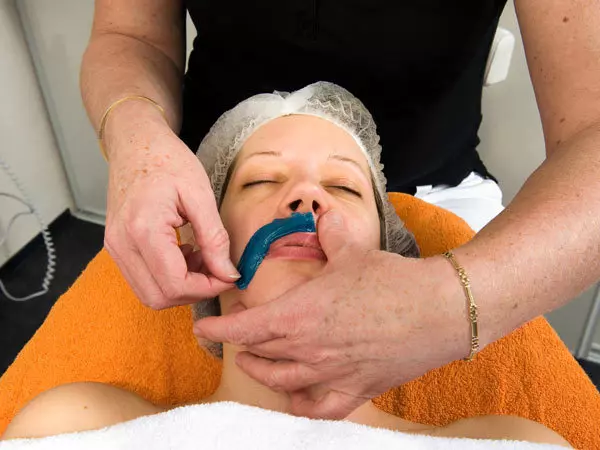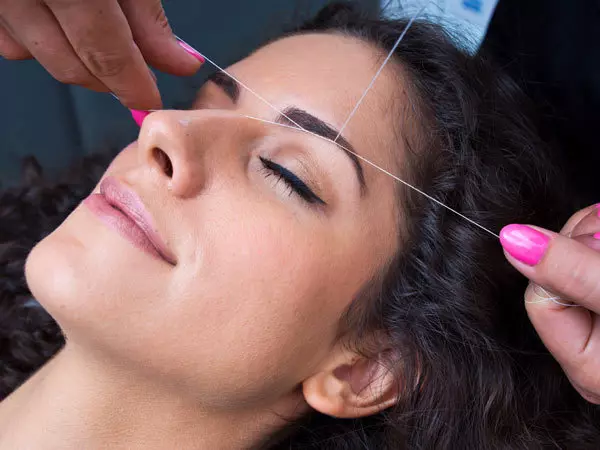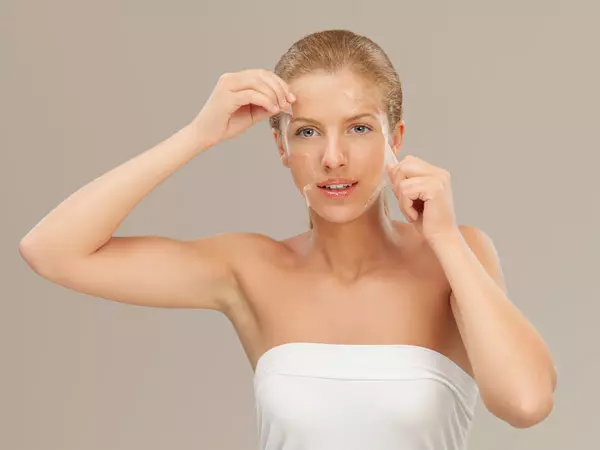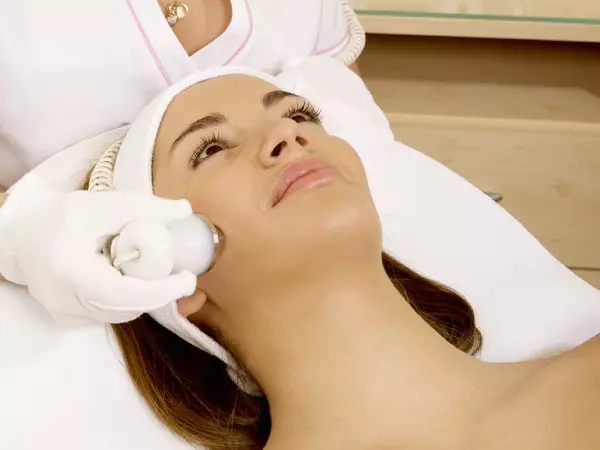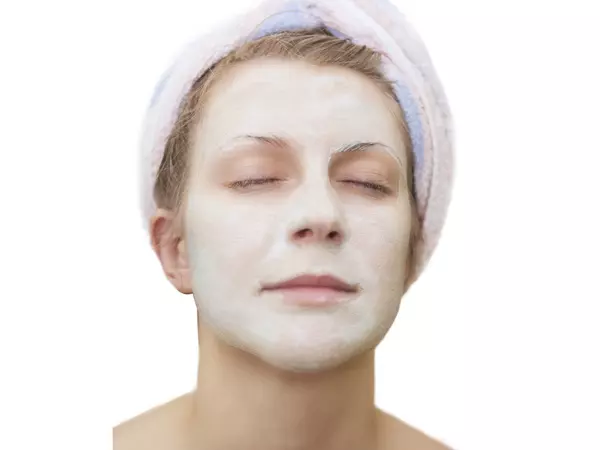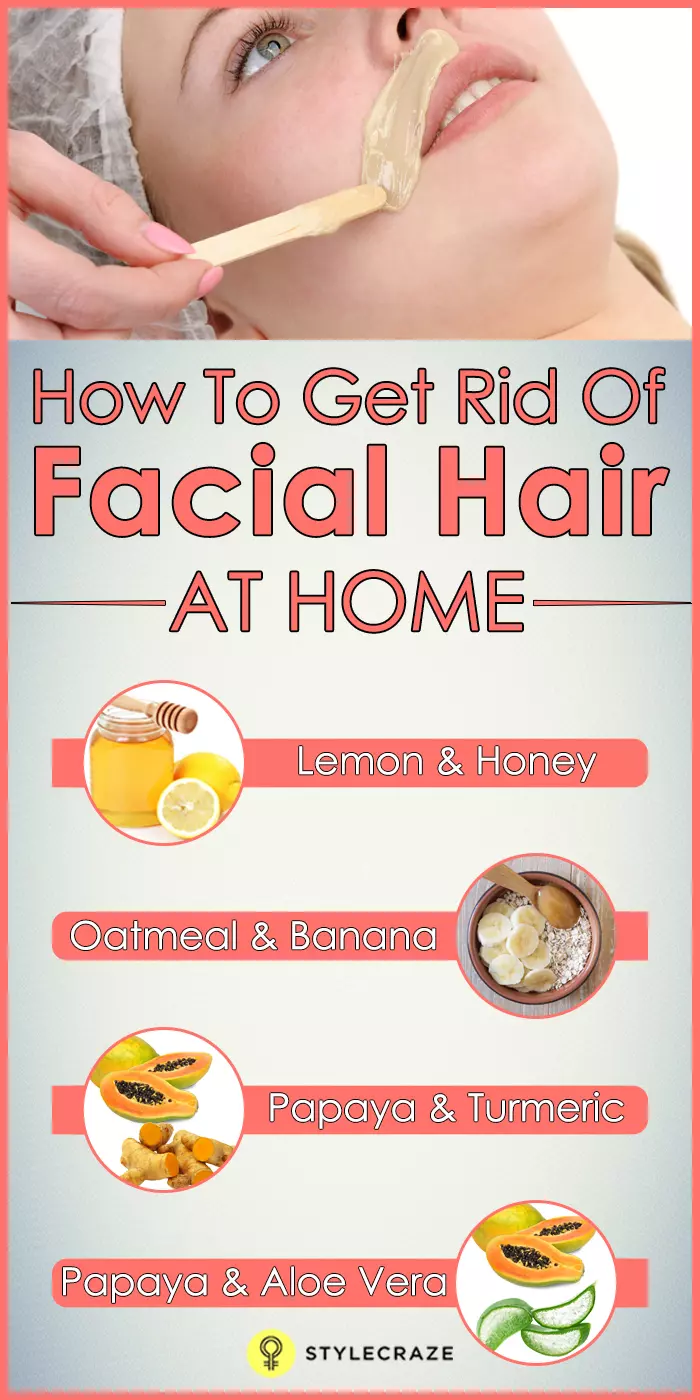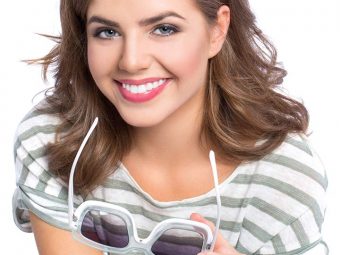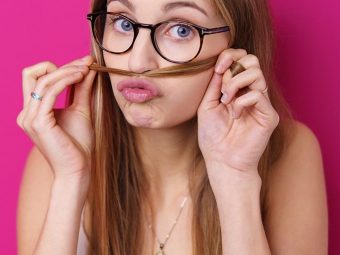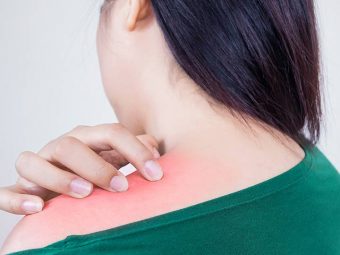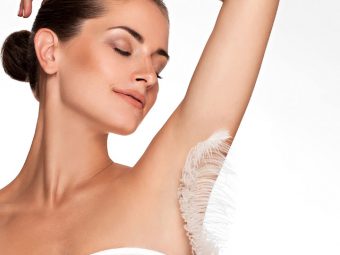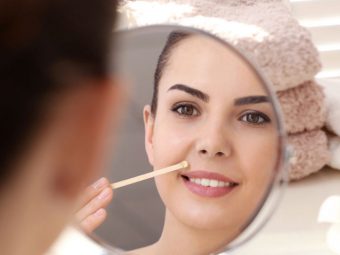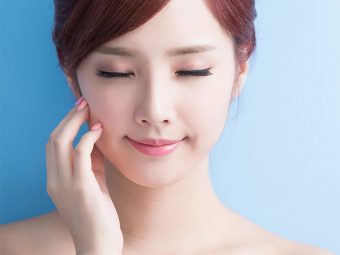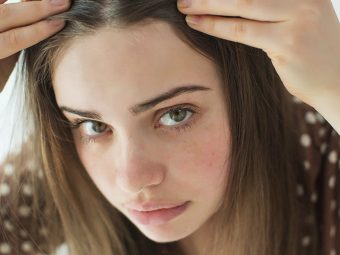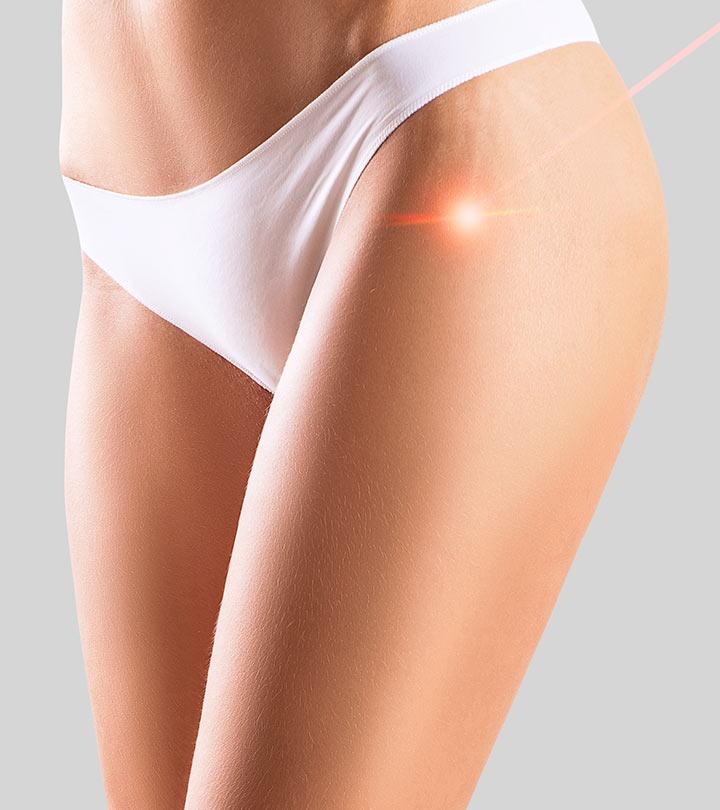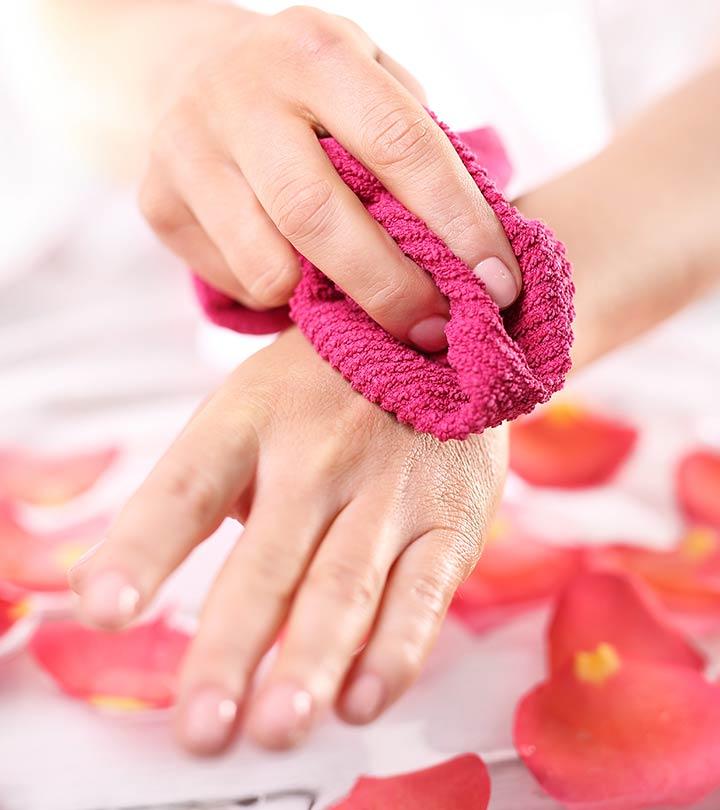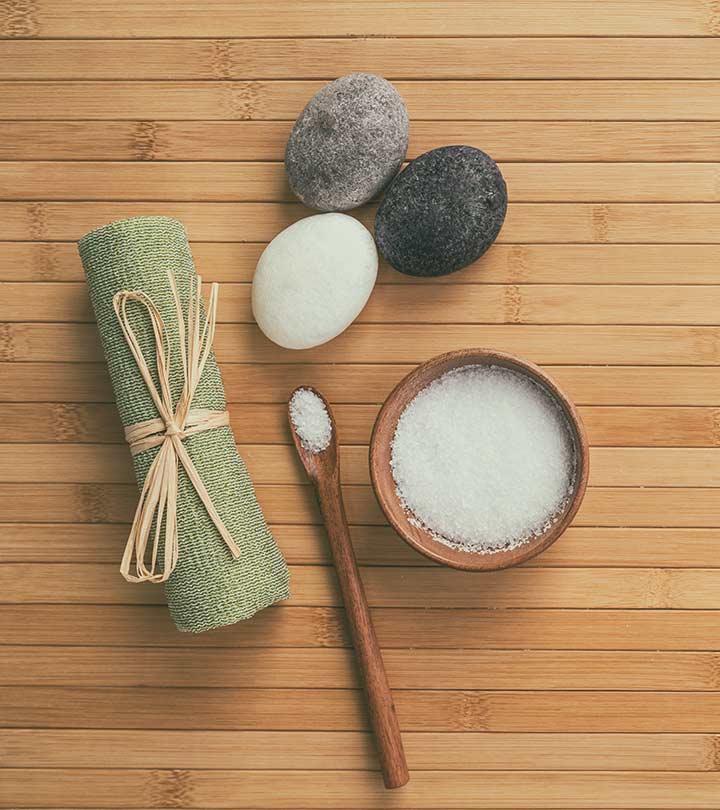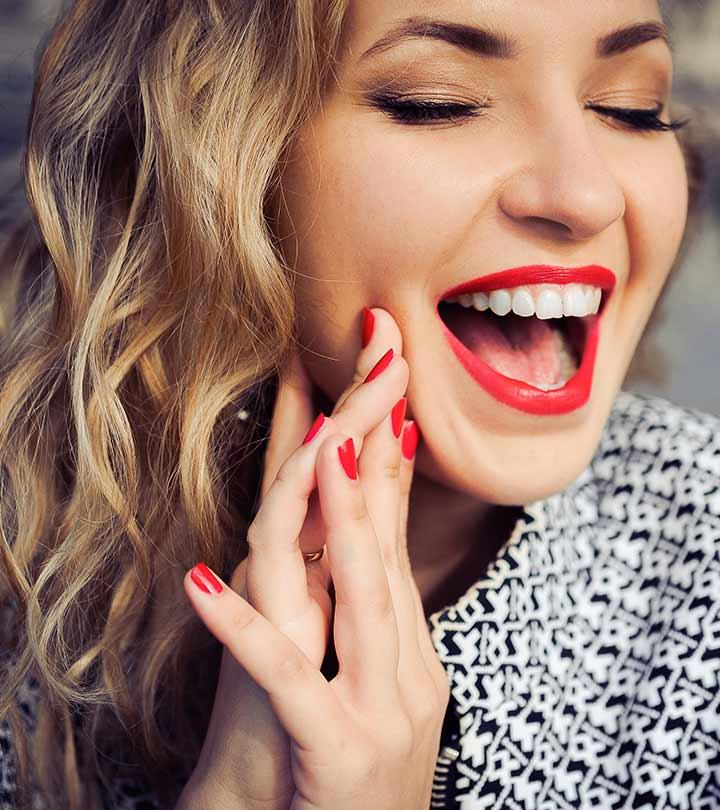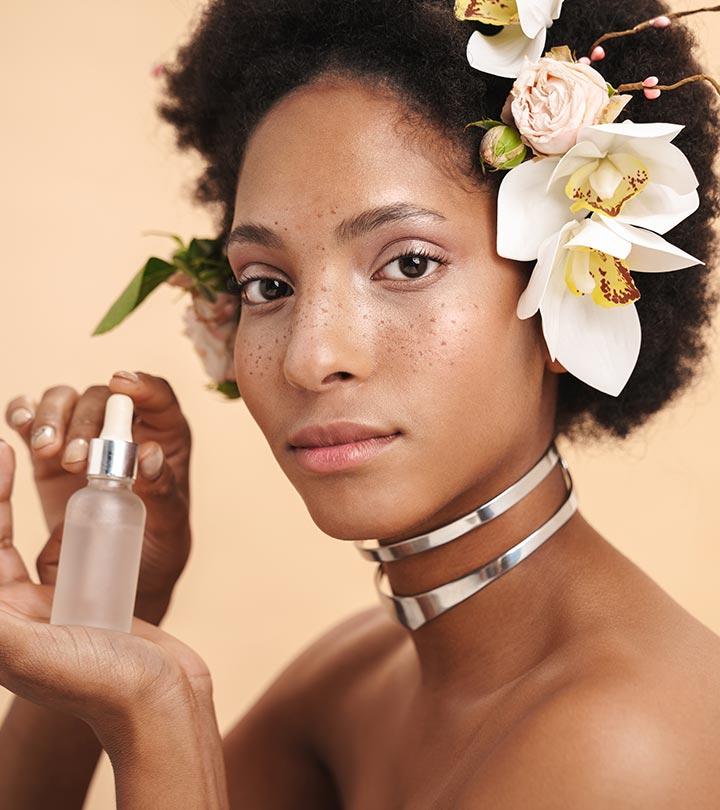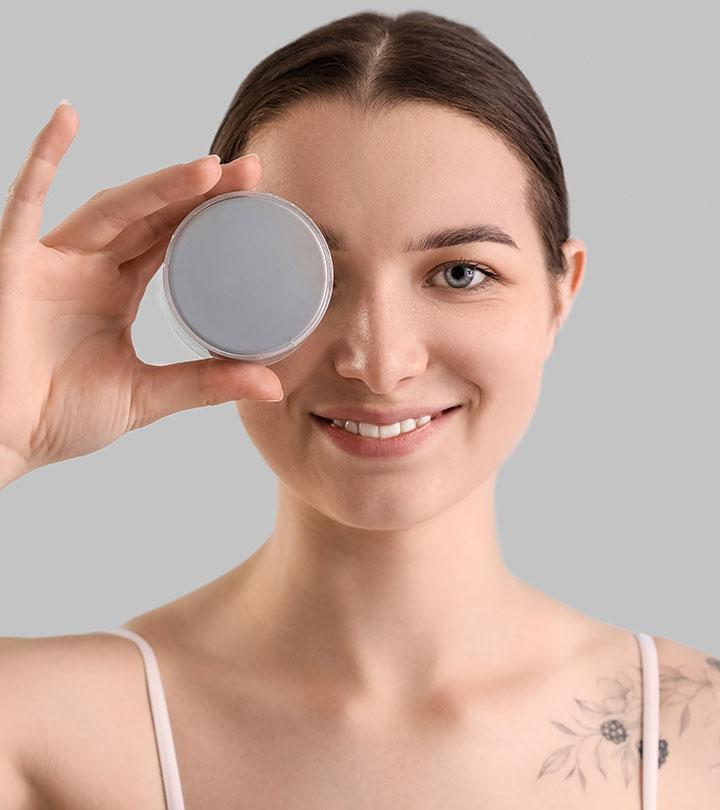27 Best Remedies To Get Rid Of Facial Hair Naturally
Painless organic methods to slowly but surely make the hair on your face disappear.
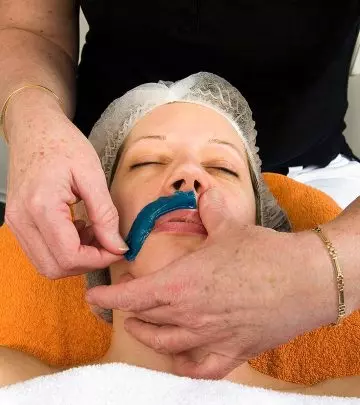
Image: Shutterstock
We want to remove facial hair, but we do not want to go through the pain and ordeal of removing it. So, how to do facial hair removal at home? Waxing and threading are the most common methods we are all familiar with. Even if we know our face does not like these and starts showing redness and soreness, we again go back to the same routine. Though we decide never to do these again, we do the same thing the next time we have a function. And it repeats! But what if you can remove facial hair at home? With natural remedies? Though these cannot provide instant results, they can promise you a painless procedure with no damage to your skin. However, you should not use any ingredients if you are allergic to them. So, what are you waiting for? Let us discuss how to remove facial hair at home.
Keep reading to know more!
In This Article
Easy Home Remedies To Remove Facial Hair: This Is All You Will Need!
- Sugar And Lemon Juice
- Lemon And Honey
- Oatmeal And Banana
- Oatmeal, Honey, And Lemon Juice
- Turmeric And Rose Water/Milk
- Lentil And Potato
- Egg White And Cornstarch
- Alum And Rosewater
- Papaya And Turmeric
- Papaya And Aloe Vera
- Indian Nettle And Turmeric
- Lavender And Tea Tree Oil
- Safflower (Kusuma) Oil And Thanaka Powder
- Basil And Onion
- Fenugreek And Green Gram Powder
- Barley And Milk
- Wheat Bran And Milk
- Wheat Bran And Gram Flour
- Apricot And Honey
- Orange And Lemon Peel With Oatmeal
- Sugar And Molasses
- Gelatin And Milk
- Garlic
- Saw Palmetto
- Chaste Tree
- Black Cohosh
- Spearmint Tea
Caution: It is advisable to do a patch test before applying anything on your skin.
You will be surprised to know that there are many natural remedies to remove facial hair.
1. Sugar And Lemon Juice
What You Need
- 2 tablespoons of sugar
- 2 teaspoons of fresh lemon juice
- 8-9 teaspoons of water, or enough to create a granular paste
What You Have To Do
- Mix the sugar, lemon juice, and water. The sugar particles act as an exfoliating agent.
- Heat the mixture.
- Let it cool a bit, and apply on the affected areas in the direction of the hair growth.
- Let it dry.
- Keep it on for about 20 minutes.
- Wash it off with cold water, rubbing in a circular motion.
How Often You Should Do This
Try to follow this regime three times a week. You will start to see results after a couple of weeks.
Why This Works
Sugar has been used since ancient ages for removing unwanted hair. Warm sugar sticks to the hair, and not the skin. So, after it has dried, it rips the hair off when we start removing it from our face. Also, sugar is only slightly warmed for application. Therefore, it causes less discomfort, unlike wax, which has to be heated to much higher temperatures. The lemon in the mixture lightens the skin tone, and bleaches the remaining hair, if any.
Suitable For
All skin types. Those with dry skin should avoid keeping it on for more than 20 minutes.
Caution
Be careful not to overheat it, or you can get scalded. Also, don’t keep it on for more than 30 minutes, as the citric acid in lemon juice may dry your skin out and make it flaky.
2. Lemon And Honey
What You Need
- 2 tablespoons of sugar
- 2 teaspoons of fresh lemon juice
- 1 tablespoon of organic honey
- 1 to 2 teaspoons of cornstarch or all-purpose flour
- Water, if required
- A waxing strip or a piece of cloth
What You Have To Do
- Mix the sugar, lemon juice, and honey.
- Heat the mixture for about 3 minutes, till it becomes a waxy paste.
- To make the paste thinner, you can add water. Ensure that the paste is smooth.
- Allow the mixture to cool down.
- Apply the cornstarch or the flour on the areas where you have unwanted hair.
- Next, spread the paste in the direction of the hair growth.
- Using a waxing strip or the piece of cloth, pull the hair out in the opposite direction.
How Often You Should Do This
Try to follow this regime two to three times a week. You can prepare this mixture in larger quantities for waxing your back, arms, and legs as well.
Why This Works
The process is similar to that of general waxing, except that it uses natural ingredients, which are, as you know, much better for your skin than their chemical counterparts.
Suitable For
This is particularly suitable for women with dry skin. Honey has amazing moisturizing properties. It prevents evaporation of water from the skin and stimulates sebum production (1).
Caution
Do not overheat the mixture. Those with sensitive skin should opt for a different method.
3. Oatmeal And Banana
What You Need
- 2 tablespoons of oatmeal
- 1 ripe mashed banana
What You Have To Do
- Blend the oatmeal and the mashed banana.
- Apply the paste on the desired areas.
- Using a circular motion, massage the paste for about 15 minutes. Rub against the direction of the hair growth.
- Wash it off with cold water.
How Often You Should Do This
Apply it once a week and – voila, you will be rewarded with glowing skin! This paste can also be used as an exfoliator.
Why This Works
Oatmeal contains avenanthramide class of antioxidants, which reduces skin redness and itching (2). Hence, using an oatmeal-based scrub gives you soft, hydrated, and smooth skin, in addition to a face free of unwanted hair. Oatmeal also has humectant properties that enable your skin to retain moisture.
Suitable For
All skin types.
4. Oatmeal, Honey, And Lemon Juice
What You Need
- 1/2 teaspoon of coarsely grounded oatmeal
- 1 tablespoon of honey
- 1/2 teaspoon of fresh lemon juice
What You Have To Do
- Blend oatmeal, honey, and lemon juice to get a paste.
- Apply this mixture on your face.
- Leave it on for about 15 to 20 minutes.
- Now, gently rub your face in a circular motion for about 5 minutes. Rub against the direction of the hair growth.
- Wash it off.
How Often You Should Do This
You can apply this mixture twice a week. Leave a gap of at least 2 days in-between applications.
Why This Works
Oatmeal, as mentioned earlier, soothes your skin. Since waxing is a painful process that causes skin irritation, it is a good idea to use oatmeal to remove hair. Honey soothes dry skin, and lemon juice acts as a mild bleach and makes your skin tone lighter. Together, these ingredients can work wonders in removing the hair on your face.
Suitable For
All skin types.
Caution
Don’t do too much too soon. Lemon juice, when used in excess, can make your skin flaky and dry.
5. Turmeric And Rose Water/Milk
What You Need
- 1 to 2 teaspoons of turmeric
Rose water or milk
What You Have To Do
- Soak the turmeric powder in rose water or milk (you can use tap water if you don’t have any of the ingredients at home, and are feeling too lazy to go buy them!).
- Blend into a smooth paste.
- Apply the paste on the areas where you have unwanted hair.
- Keep it on for about 15-20 minutes – or till it dries up.
- Wash it off with warm water.
- To remove thick hair, you can add gram flour, ground oats, or rice flour to the mixture.
How Often You Should Do This
You can do this every other day if you want.
Why This Works
Turmeric has been used for treating skin diseases like eczema and for healing wounds for centuries in India (3). It has amazing antibacterial and antiseptic properties (4). Therefore, it is an ideal agent for removing hair as it protects the skin after the hair has been ripped off.
Suitable For
Turmeric and rose water mixture is ideal for oily skin, while turmeric and milk mixture is amazing for dry skin. Those with normal skin, take a pick.
Caution
Too much turmeric may give your skin an unhealthy, yellow tint. So, if you are using this every other day, ensure that you use just a pinch of it. Also, it is not advisable to use soap after using turmeric, as it may darken your skin. Even though there is no scientific information to back this up, this piece of advice has been handed down to every generation in most families. So, better be safe than sorry!
6. Lentil And Potato
What You Need
- Yellow lentil, soaked in water overnight
- A potato
- 1 tablespoon fresh lemon juice
- 1 teaspoon honey
What You Have To Do
- Peel the skin off the potato and mash it.
- Extract the juice from the mashed potato.
- Drain the water in which the lentils had been soaked. Grind the lentils to a smooth paste.
- Add the potato juice to the yellow lentil paste.
- Add the lemon juice and honey to this mixture.
- Apply this mixture on the areas where you have unwanted hair.
- Leave it on for about 20-30 minutes, till the paste completely dries out.
- Start rubbing your fingers over the dried paste to remove it.
How Often You Should Do This
You can do this one or two times a week.
Why This Works
Potatoes have several skin benefits. The high amount of catecholase in potatoes helps in lightening your skin tone (5). Therefore, using the lentil and potato mixture not only eliminates unwanted hair, but also makes your skin look brighter.
Suitable For
All skin types. Those with dry skin, if your skin starts to dry out after using this remedy, you can use a moisturizer that is fragrance and alcohol-free after washing your face.
Caution
Some people are allergic to raw potatoes. They complain of itchy hands and skin rashes if they peel, scrape, or even touch potatoes. So, if you have never stepped into the kitchen, and not really sure of what reaction your skin will have to potatoes, ensure that you do a patch test before applying this.
7. Egg White And Cornstarch
What You Need
- An egg
- 1 teaspoon of cornstarch
- 1 tablespoon of sugar
What You Have To Do
- Separate the egg white from the yolk.
- Add cornflour and sugar to the egg white.
- Whisk it till it forms a smooth paste.
- Apply it on the areas that have unwanted hair.
- Keep it on for about 20-25 minutes, till it is completely dry.
- Once it’s dry, peel it off.
How Often You Should Do This
Follow this regime 2-3 times a week for best results. It might be slightly painful…but not more than those wax strips, trust me!
Why This Works
Egg whites are the perfect way to get rid of unwanted hair. It is sticky and forms a thin film on your facial hair. That helps to rip the hair off when it dries up. The sugar also adds to the stickiness of the mixture and cornflour gives it a thick and smooth consistency, making depilation easier.
Suitable For
Not for acne-prone and sensitive skin.
Caution
For those with acne-prone skin, using this remedy can result in clogging of the pores and increase the possibility of breakouts. Also, the presence of salmonella bacteria in the egg might lead to skin infections, especially if you apply it on broken skin. Those with sensitive skin, you should know that egg whites contain vitamin A, which may lead to breakouts and increased sensitivity.
8. Alum And Rosewater
What You Need
- 1/2 teaspoon of alum powder
- 2 to 3 tablespoons of rose water
- A few drops of sesame oil or olive oil
What You Have To Do
- Add rose water to the alum powder and make a paste.
- Take a cotton ball and dip it in the mixture.
- Apply the paste on the areas where you have unwanted hair.
- Allow it to dry. Follow it up with another application of the mixture.
- Repeat this dry-and-apply process 5 to 6 times. If you have sensitive skin, 3 to 4 times is enough.
- Wash it off.
- Apply sesame oil or olive oil to moisturize the area.
How Often You Should Do This
You should do this at least once a week, if possible three days a week. Alum powder is easily available in the market. If you don’t get it in powdered form, simply grind the alum chunks.
Why This Works
Alum has been used traditionally by Asian women to inhibit hair growth. It has been shown to have worked wonders in inhibiting the growth of hair. It can also be used as an after-wax product as it cools the skin as well.
Suitable For
All skin types.
Caution
It may cause a stinging sensation. Alum can cause irritation of the skin and mucous membranes.
9. Papaya And Turmeric
What You Need
- 2 tablespoons of raw papaya paste
- ½ teaspoon of turmeric powder
What You Have To Do
- Peel the raw papaya and cut it into little pieces.
- Grind the pieces to make a fine paste.
- Mix the papaya paste with half a teaspoon of turmeric powder.
- Apply this mixture on the affected parts.
- Massage for 15 to 20 minutes.
- Wash it off.
How Often You Should Do This
Follow this regime 2 to 3 times a week for best results.
Why This Works
The papain enzyme present in raw papaya dilates the hair follicles, causing the hair to fall out (6). Papaya is also very good for skin. It works as an exfoliator, removing the dead skin cells. Those with sensitive skin, fret not! This is perfectly suitable for you.
Suitable For
All skin types.
10. Papaya And Aloe Vera
What You Need
- 1 tablespoon papaya paste
- 2 to 3 tablespoons of aloe vera gel
- 1 tablespoon of mustard oil
- ½ teaspoon gram flour
- ½ teaspoon turmeric powder
- 2 drops of any essential oil
- A clean and dry cloth
- 1 teaspoon of olive oil (you can opt for a moisturizer as well)
What You Have To Do
- Mix the papaya paste, aloe vera gel, gram flour, turmeric powder, mustard oil, and essential oil to make a thick paste.
- Apply this paste on the areas you need to remove hair from.
- Allow the paste to dry. Keep it on for about 15 to 20 minutes.
- Start rubbing the cloth in the opposite direction of the hair growth to remove the dried paste.
- Wash off with water and pat dry.
- Massage a few drops of olive oil, baby oil, or moisturizer on the sensitized area.
How Often You Should Do This
This remedy should be used 3 to 4 times a week for about three months for best results.
Why This Works
As mentioned earlier, papaya’s papain enzyme makes the hair to fall out.
Suitable For
All skin types.
Caution
Don’t use soap for washing it off.
11. Indian Nettle And Turmeric
What You Need
- A handful of Indian nettle leaves
- ½ teaspoon turmeric powder
What You Have To Do
- Wash the Indian nettle leaves properly.
- Grind them to make a paste.
- Add the turmeric powder to the paste.
- Apply this paste on the areas where you have unwanted hair.
- Let it stay for a couple of hours.
- Wash it off.
How Often You Should Do This
You can apply this paste before going to bed and keep it on overnight. Wash it off the next morning. Follow this regime every day for four to six weeks to get rid of unwanted hair.
Why This Works
Indian nettle, when combined with turmeric, penetrates the skin and, over time, thins the hair. Turmeric’s antibacterial and anti-inflammatory properties act as a safeguard against skin infections and allergies.
Suitable For
All skin types. However, a patch test is strongly recommended.
Caution
May induce temporary skin irritation and itching if you are allergic to it.
12. Lavender And Tea Tree Oil
What You Need
- 1 teaspoon lavender oil
- 4 to 5 drops of tea tree oil
What You Have To Do
- Mix the oils.
- Apply this mixture on the areas where you have unwanted hair. You can use a cotton ball for the application.
How Often You Should Do This
Repeat this process a couple of times daily for at least three months to see results.
Why This Works
Many women suffer from excessive terminal hair on androgen-dependent areas of their body, such as the breasts or chin, because of a medical condition called hirsutism (7). Women suffering from hirsutism have excessive growth of hair on their face and body. The hair is generally dark and coarse. It usually appears where men typically have hair – on the face, chest, face, and back. Lavender and tea tree oils may have antiandrogenic properties, and therefore, when applied topically, might reduce the growth of hair.
Suitable For
Not for those with acne-prone skin.
Caution
The tea tree oil may cause skin irritation, swelling, skin dryness, itching, stinging, burning, and redness in people having acne-prone skin. Do not consume the mixture.
13. Safflower (Kusuma) Oil And Thanaka Powder
What You Need
- ½ tablespoon safflower oil
- ½ tablespoon thanaka powder
- A pinch of turmeric
What You Have To Do
- Wax the area.
- Wash the area thoroughly.
- Mix the Kusuma oil and Thanaka powder.
- Apply the mixture on the area.
- Massage it gently against the direction of the hair growth for about 10 minutes.
- Leave it on for a while, preferably overnight.
How Often You Should Do This
Repeat this process three to four times a week for four months. It is not required to wax the area every time you apply the mixture, but it is absorbed better when the hair has been removed. The paste should be creamy, not watery.
Why This Works
It has been vouched for by many people who have used this remedy to get rid of unwanted hair. It is a trusted Ayurvedic method.
Suitable For
All types of skin.
Caution
It is an Ayurvedic remedy that does not have much scientific backing. Therefore, make sure that you do a patch test to ensure that you are not allergic to the ingredients.
14. Basil And Onion
What You Need
- 2 Onions
- Handful of basil leaves
What You Have To Do
- Cut the onions.
- Pull out the thin transparent membranes from between the onion layers.
- Crush the basil leaves.
- Mix both and grind to make a paste.
- Apply this paste on the areas you have unwanted hair.
- Leave it on for about 20 minutes.
- Wash off with water.
How Often You Should Do This
Repeat this three to four times a week for a couple of months or to get rid of your unwanted hair.
Why This Works
This is one of the best home remedies for facial hair removal and has been used by women since ages. Onion has many skin, hair, and health benefits. It facilitates hair growth! However, it has been observed that when used with basil leaves, onion can get rid of unwanted hair.
Suitable For
All types of skin.
15. Fenugreek And Green Gram Powder
What You Need
- 2 teaspoons of fenugreek seeds
- 2 teaspoons of green gram
- Water (enough to make a paste)
What You Have To Do
- Grind fenugreek seeds and green gram to powder them.
- Mix both the herbal powders.
- Add water to make a paste.
- Apply this paste on the areas where you have unwanted hair.
- Allow it to dry.
- Gently rub the paste off.
- Wash the area with chilled water.
How Often You Should Do This
Use this remedy 2 to 3 times a week for best results.
Why This Works
The paste sticks to the hair on the face when it dries. Once we start rubbing it, the hair stuck to the dried paste comes off as well.
Suitable For
Those with sensitive skin, don’t rub too hard, or you will develop rashes.
Caution
Fenugreek can cause facial swelling, nasal congestion, coughing, wheezing, and severe allergic reactions in hypersensitive people.
16. Barley And Milk
What You Need
- 1 tablespoon barley powder
- 1 tablespoon milk
- 1 teaspoon lemon juice
What You Have To Do
- Blend barley powder, milk, and lemon juice to make a paste.
- Apply this on the areas where you have unwanted hair.
- Leave it on for 30 minutes.
- Rub it off.
How Often You Should Do This
Follow this regime 3 to 4 times a week. This mixture can also be used as a scrub. When used regularly, it will give you amazingly soft and supple skin.
Why This Works
Barley and milk paste sticks to the hair on the face when it dries. Once we start rubbing it, the hair stuck to the dried paste comes off as well.
Suitable For
Those with sensitive skin, don’t rub too hard.
Caution
Barley flour, when inhaled, can sometimes cause asthma.
17. Wheat Bran And Milk
What You Need
- 2 tablespoons wheat bran
- 1 tablespoon milk (or enough to make a paste)
- 1 teaspoon rosewater
What You Have To Do
- Mix wheat bran, milk, and rosewater and make a paste.
- Apply the mixture on your face.
- Massage it on your face using gentle, circular motions.
- Keep on massaging till the mixture dries up.
- Wash it off with water.
How Often You Should Do This
You can do this daily. If you have sensitive skin, you can use it thrice a week.
Why This Works
The paste starts sticking to the hair as it dries. Once we start massaging it, the hair stuck to the dried paste comes off as well. Wheat bran is the product that remains after we refine the grain of wheat. Because of its high nutrient content, it is used in several cosmetic products such as scrubs and wrinkle creams. Why resort to those expensive OTC products when you can get this awesome product almost for free? (I did say “almost”).
Suitable For
All skin types.
18. Wheat Bran And Gram Flour
What You Need
- 2 tablespoons wheat bran
- 1 tablespoon gram flour
- 1 tablespoon fresh milk cream (If you have oily skin, opt for a tablespoon of curd instead).
- ½ teaspoon turmeric
What You Have To Do
- Mix wheat bran, gram flour, turmeric, and milk cream/curd and make a paste.
- Apply this on your face.
- Leave it on for about 20 minutes.
- Rub your face in gentle, circular strokes using wet fingers.
- Massage for about 5 minutes.
- Wash it off.
How Often You Should Do This
Follow this regime thrice a week to get soft, smooth, glowing, and ‘hair-free’ skin.
Why This Works
This paste, too, sticks to your hair as it dries. Once we start rubbing it, the hair stuck to the dried paste comes off as well.
Suitable For
Those with oily skin, opt for the curd. Adding milk to the mixture might cause a breakout.
Caution
Don’t use soap to wash it off.
19. Apricot And Honey
What You Need
- 2 tablespoons powdered apricots
- 1 teaspoon honey (or enough to make a paste)
What You Have To Do
- Add the honey to the apricot powder.
- Apply this on your face.
- Leave it on for about 15 minutes.
- Massage the mixture into your skin with your fingers using gentle, circular strokes for about 10 minutes.
- Wash it off. You can use lukewarm water for this.
How Often You Should Do This
Repeat this thrice a week for best results.
Why This Works
The paste, once dry, helps to pull the stuck hair off as well. Apricots are an excellent source of antioxidants, and we all know how antioxidants benefit our skin (8). Add to that the amazing antimicrobial and antioxidant properties of honey – and you have the secret to pretty skin (9).
Suitable For
Those with oily skin might experience breakouts.
20. Orange And Lemon Peel With Oatmeal
Seen those ads where the models peel off an orange mask from their faces to reveal glowing, brighter skin? Well, the “brighter” part can be vouched for by the fact that most of the tiny hairs on their face get ripped off along with the mask. But why opt for chemical-laden products when you can make yours right at home?
What You Need
- 1 tablespoon powdered orange peel
- 1 teaspoon powdered lemon peel
- 1 teaspoon oatmeal
- 1 teaspoon powdered almond
- 2 teaspoons olive oil
- 1 teaspoon rose water
What You Have To Do
- Mix the orange peel powder, lemon peel powder, almond powder, and oatmeal.
- Add rose water to it.
- Add olive oil to the mixture and make a paste.
- Apply it on your face.
- Leave it on for 5 minutes.
- Massage it in gentle, circular strokes, against the direction of the hair growth.
- You can do this for about 10 minutes.
- Wash it off with chilled water.
How Often You Should Do This
You can apply this mixture thrice a week for best results. The powdered forms of all these ingredients are easily available online – gone are the days when we had to grind the peel ourselves. All you need to do is follow this regime religiously to win the war against unwanted hair.
Why This Works
The paste is very sticky and forms a film on the face when it dries. Once we start massaging it, the hair stuck to the dried paste comes off as well.
Suitable For
Those with sensitive skin can give this one a miss.
Caution
Make sure that you don’t apply the mixture on your eyebrows.
21. Sugar And Molasses
Sugar and molasses are used in hair removal creams as they work wonders in pulling off unwanted hair (10). And they also leave behind a sweet fragrance. What more can you ask for?
What You Need
- 2 tablespoons sugar
- 1 tablespoon lemon juice
- Molasses
- Cloth or a waxing strip
What You Have To Do
- Mix the sugar and molasses, and heat the mixture till the sugar dissolves completely.
- Add the lemon juice.
- Let the mixture cool down.
- Apply on the affected areas in the direction of the hair growth.
- Cover it with a cloth or a waxing strip.
- Pull it off in the opposite direction of hair growth.
How Often You Should Do This
Whenever required. Yes, an ‘ouch’ method, but very effective and gives instant results.
Why This Works
The paste is extremely sticky and gooey and sticks to the hair when it dries. The process is similar to waxing.
Suitable For
Not for those with sensitive or acne-prone skin.
Caution
Make sure that the mixture isn’t too hot before application, or you might end up with scalded skin.
22. Gelatin And Milk
What You Need
- 1 tablespoon unflavored gelatin
- 2-3 tablespoons of milk
- 1-2 drops of lavender essential oil/ a few drops of lemon juice
What You Have To Do
- Mix the gelatin, milk, and essential oil/lime juice and make a paste.
- Heat it slightly.
- Apply immediately on the areas where you have unwanted facial hair. Make sure that the mix is not too hot.
- Allow it to dry.
- Peel it off.
How Often You Should Do This
Whenever you want instant results. Positive aspect: It will take care of the blackheads as well. Negative: It’s icky and sticky. This is my least favorite of all the home treatments. It’s sticky and smelly, but, well, beggars can’t be choosers! And if you have nothing else at home, this is an excellent go-to product as it works very well on stubborn hairs.
Why This Works
The paste is extremely sticky and gooey and sticks to the hair when it dries. When you start peeling it off, the hair comes off as well.
Suitable For
Not for those with sensitive or acne-prone skin.
Caution
Please be careful while applying this mixture – ensure that you keep it away from your eyebrows. In case you apply it on them accidently, don’t panic. Dip a cotton ball in water and wipe it off. If it still sticks to your eyebrows, wash it off using lukewarm water.
23. Garlic
What You Need
- 1 teaspoon freshly squeezed garlic juice
What You Have To Do
- Massage the garlic juice on the areas where you have unwanted hair.
- Keep it on for 30 minutes.
- Wash it off with lukewarm water.
- Apply a fragrance-free moisturizer.
How Often You Should Do This
You can apply the juice once every day. You can continue to do this till the hairs fall off.
Why This Works
There is not enough scientific data to back up the claim that using garlic juice gets rid of unwanted hair. However, many women who have tried this method have vouched for its effectiveness. Unless you are allergic to garlic, there is no reason for not trying it. As it is, garlic has several beauty benefits.
Suitable For
Not for those with hypersensitive skin. A patch test is strongly recommended.
Caution
May induce allergic reactions and asthma. Has a strong odor, so avoid applying it before going out.
24. Saw Palmetto
Saw palmetto (Serenoa repens) is a small palm-like plant with fan-shaped leaves and sharply toothed stalks. It is native to the Southeastern US. It has antiandrogenic effects, due to which it lowers levels of androgeni , the male sex hormone in the body (12) androgeni XA group of hormones that is responsible for a male's sexual development and crucial for reproductive function. , the male sex hormone in the body. Therefore, it reduces the growth of excessive body hair as well.
How to Take It
Saw palmetto can be purchased as dried berries, tablets, powdered capsules, liquid tinctures, and liposterolic extracts. Ensure that the product is a fat-soluble saw palmetto extract that contains 85 to 95 percent fatty acids and sterols, and is standardized. You can consume the liquid extract as well, but this preparation has not been tested yet, so its effectiveness is not known. You may be wondering, why not brew the amazing saw palmetto, and have it as tea? Unfortunately, its fatty acids (active ingredients) are not soluble. So tea may not be that effective
Dosage
The appropriate saw palmetto dosage hinges on an individual’s age and overall health. While there is no universally recognized standard dose, research typically employs daily quantities ranging between 160 mg and 320 mg. It is of utmost importance to adhere to the dosage recommendations provided by the manufacturer or seek guidance from a healthcare professional.
Caution
Saw palmetto is not recommended for children. So keep the tiny tots away from it. It may also increase the risk of bleeding. If you consume hormone medications such as birth control pills; blood thinners such as warfarin (Coumadin), clopidogrel (Plavix), or aspirin; or suffer from hormone-sensitive illnesses, consult your doctor before having this herb.
25. Chaste Tree
Chaste tree (Vitex agnus-castus), also known as Chasteberry, is a flowering plant. It is a native of the Mediterranean region and has traditionally been used to correct hormone imbalances. Its standardized extract has antiandrogenic effects. It is primarily used as an herbal remedy for Polycystic Ovarian Syndrome (PCOS), which is one of the major causes of hirsutism. Therefore, if your excessive hair growth is due to PCOS, chasteberry extract will take care of it. It facilitates the production of the luteinizing hormone by acting on your hypothalamusi XThe core of the brain, from which all functions are controlled, including hunger, thirst, and sexual behavior. and pituitary glands.
As a result, the release of the follicle-stimulating hormone is mildly inhibited. Therefore, consuming the chaste tree extract will balance the right hormones essential for women (increase progesterone hormone as compared to estrogen hormone), and treat their menstrual problems related to PCOS. As a “side effect”, you will get rid of excessive hair as well!
Dosage
For PCOS patients, a dosage of 40 drops or 175 mg (0.6% aucubin standardized extract) per day is recommended. But further research is needed to back up the claim. However, consult your health provider to know about the right dosage for you.
Caution
If you consume hormone medications, such as birth control pills, or are suffering from hormone-sensitive illnesses, consult your health provider before taking chaste tree. This herb can interfere with some Parkinson’s medicines and antipsychotic drugs too.
26. Black Cohosh
Black cohosh (Actaea racemosa), a plant of the buttercup family, is a flowering plant native to eastern North America. It has antiandrogenic effects and many other health benefits. It is used as an alternative medicine for treating hirsutism. However, there is a lack of high-quality evidence supporting the effectiveness of black cohosh for the same reason.
How to Take It
It can be consumed in the form of tea.
What You Need
- 20 gms or 1 ½ tablespoons of dried black cohosh root
- 1 teaspoon honey
¼ cups of water
What You Have To Do
- Put the black cohosh root in the water.
- Stir it and place this on the stove.
- Bring to boil.
- Let it simmer for about half an hour, till you have 1/3 of its original quantity.
- Turn the stove off and strain it.
- Add honey, if required.
- Let it cool completely.
- You can store this in the fridge.
You can store the tea in the fridge for more than 2 days. Drink a cup of this tea thrice a day. Drinking too much of it can lead to headaches, nausea, abdominal discomforts, and dizziness, among others.
Caution
Do not consume black cohosh if you have liver disease. If you have a clotting disorder, stay away from this herb as it may increase the risk of blood clots. Also, if you take hormone medications or suffer from hormone-sensitive illnesses, consult your doctor before consuming it.
 Quick Tip
Quick Tip27. Spearmint Tea
Spearmint tea (Mentha spicata) helps to lower the testosterone levels in the female body and controls the excessive production of androgen.(16). So, if you sip on this amazing tea regularly, you can bid adieu to your facial hair.
What You Need
- A handful of spearmint leaves
- 4 ¼ cups of water
- Honey/ sweet cream/ milk
What You Have To Do
- Pour the water into a container.
- Rinse the spearmint leaves thoroughly.
- Put the leaves in the container and place it on low heat.
- Do not over boil it.
- Strain it.
- Add whatever you like – honey, sweet cream, or milk.
Dosage: 1 cup, 2 times a day
Caution: There are some magical potions and herbs (yes, I am kidding about the magical part) that, when consumed, treat hirsutism. However, you must always consult your health care provider before opting for any herbal treatment that can affect hormones. Experts in alternative medicine promote the use of these herbs for the treatment of hirsutism, but most have not been tested by scientists. NEVER take these supplements if you are pregnant, breastfeeding, planning to become pregnant, or have a history of breast, uterine, or ovarian cancer, or other hormone-related conditions (except when recommended by your doctor).
 Quick Tip
Quick TipFacial hair can be a menace! Some popular ways to ward off the re-growth of those pesky facial hairs include shaving, tweezing, electrolysis, and laser. However, except electrolysis, all other solutions are temporary. Here we discuss some commonly used methods to tackle facial hair.
Other Methods To Remove Facial Hair
Here are some common facial hair removal methods for you.
1. Waxing
2. Threading
3. Using Peel-Off Masks
4. Tweezing
5. Electrolysis
6. Laser Hair Removal
7. Bleaching
8. Shaving
9. Hair Removal Cream
10. Epilators
1. Waxing
This is a fairly familiar method for facial hair removal. Sometimes don’t we just beg the lady at the salon to wax that ugly mustache off just to spare yourself the pain of threading? Not that this doesn’t hurt but it is a lot less painful than threading.
When it comes to the face, waxing is an efficient hair removal technique to wipe away the unwanted hair on the sides of the face as well as the upper lip area. However, it is highly recommended to avoid waxing the chin area as it tends to be coarser and you can end up with skin irritation.
The waxing procedure happens to be quite painful and may prove problematic for darker complexioned beauties, whose skin at times gets irritated and inflamed while waxing. Many dermatologists advise to not go for a wax for facial hair. Hair is pulled from the roots of the skin causing premature aging. Skin also loses its elasticity.
Jen, a beauty blogger, shared in her blog that waxing often causes breakouts on her chin. However, she preferred the method because of the end result. She said, “Results can last about 2-3 weeks before I start to get noticeable hair regrowth (i).”
2. Threading
This is a technique that we are all well aware of. In this technique, they are using a thin thread to rip out the hair one by one on our face, it is never pleasant. We invariably walk out almost ready to cry!
Threading is a very common method to remove hair from the roots. A thin strand is twisted around itself and then used to remove the hair from the roots. This is the most preferred answer for the question on how to get rid of facial hair in salons. It gives good results; however, its effect does not last long. You have to thread regularly so that the hair growth becomes less frequent.
Jen tried this method on her chin and eyebrows and found that her skin recovered quicker than it did with waxing. However, she felt it was more painful than waxing. She said, “Results probably last 2 weeks-ish for me, but it can be longer depending on how long your hair takes to regrow.”
3. Peel-Off Masks
You can also apply peel-off masks to remove facial hair. In this type of hair removal, the cream is spread on your face and is allowed to dry out. This not just adheres to the upper layer of the epidermis but also to the unwanted hair.
When peeled off, the dead and dry skin along with the unwanted hair is peeled off. This is a sure-shot way to take care of your skin and facial hair removal in one step.
4. Tweezing
Tweezing is one of the most commonly used methods of getting rid of those pesky strands on your face and other body parts. In this method, the hair is plucked from the root. This is an ideal solution for removing hair from small areas like chin, eyebrows, and upper lip area.
Like everything, tweezing treatment has some cons as well. First of all, plucking it is a time taking process and can’t be turned to for removing unwanted hair on larger body parts like legs, arms, etc. Moreover, pulling out the hair can cause irritation of the hair follicles which may lead to scarring.
5. Electrolysis
This is a permanent solution for facial hair removal. In this process, the hair is burnt from the roots using an electric current. However, this is a time-consuming process and needs a few repeats before permanence sets in. It can end up being expensive if done over a larger portion.
While many say that this process is painful, in reality, you don’t feel anything more than mild discomfort. Since the amount of hair you have on your face is decided by genes and hormones, even the number of sittings required for complete removal also depends on its thickness. However, consult your doctor before undergoing electrolysis to know whether the treatment will suit you or not. For instance, those who have pacemakers can’t go for electrolysis.
Process
A sterile probe is inserted alongside the hair in the follicle opening. A probe is different from a needle because it is a solid wire, unlike a needle which is hollow on the inside. A radio frequency is then applied to destroy the individual hair follicle that controls the development of that hair. The technician then slips the hair out of the follicle using sterilized forceps to grasp it. Once these hair cells are destroyed completely, the hair will not grow back from that follicle. The body will be unable to regenerate hair in that follicle. This may take several treatments.
6. Laser Hair Removal
And Tada! This is the latest wonder of science! Here doctors just use a high-energy light ray to burn the hair from the roots preventing regrowth in most cases and even if regrowth occurs, the hair is lighter and less dense. This permanent hair removal process is brilliant but expensive too.
Laser hair removal destroys follicles creating hair growth and you can get rid of your unwanted facial hair permanently. This process must be done in consultation with a reputed doctor. The basic mechanism behind this procedure is to selectively pick the dark cells responsible for hair growth and destroy them. A light ray at a specific wavelength and pulse is selected for this purpose. Melanin is considered the primary chromatophore or the color-producing agent that aids in hair growth. This is again of two kinds, the eumelanin and phoemelanin. The eumelanin controls the brown and black colors while the latter controls the blonde and red. The light waves sent out can be modified only to target the darker colors, and that is why laser treatment works only on this darker hair.
7. Bleaching
Bleach changes the hair color to match the skin tone. The results stay for two weeks.
Many women desperately want to have radiant, light and clear skin. They use various forms of bleaching for this purpose, the natural ones like lemon and also cosmetic bleaches. Nowadays, women are using household bleaches to make their skin glow. However, this trend can do more harm than good. Skin experts don’t recommend the use of household bleach on the face. Cream bleach is suitable for lightening dark facial hair. Facial bleach has a different concentration than body bleach. The skin on the face is prone to irritation quicker than any other part of the body. The face is more exposed to the sun compared to the rest of the body, so using face bleach is advisable.
Bleach to some extent has a corrosive effect on the skin. If a person already has dermatitis, then bleaching can aggravate the condition. Sometimes, bleaching can cause infection, hyperpigmentationi XA clinical term for dark patches of skin on the body which are caused by an increase in melanin production. and tanning. This can make the skin cancer prone.
Follow these precautions while using face bleach at home:
- Use facial bleach for face and body bleach for body
- Always do a patch test of the bleach to be used before applying it directly to the face. This patch test should be done on the arm and wait for 24 hours before using it on larger areas of the skin.
- Don’t apply the face bleach near the eyes and inside the nose or ears.
- Don’t use bleach on the scar tissue, warts and moles.
- Bleach shouldn’t be used over sunburnt, irritated and chapped skin or an area that is freshly shaved.
- Bleach isn’t safe to use on areas where chemical peels and substances like retinol is applied
- Metal and bleach don’t go well. So don’t mix bleach in a metal container.
- Avoid sun exposure after bleaching for a day.
8. Shaving
Using a razor is one of the best and easiest methods of hair removal.
- Shaving helps to get rid of unwanted hair in a quick and painless way.
- A razor with five blades works best as it gives a close shave.
- Disposable razors are great if you are especially concerned about hygiene and don’t want to reuse one.
- You don’t need to change your blade regularly as most razors come with multi-use razors.
- Make sure you avoid shaving in a very hot shower.
- Always lather and then shave to avoid getting cuts on the skin.
- Shave on the opposite side of the hair growth for best results.
- This type of hair removal can easily be done at home.
 Quick Tip
Quick Tip9. Hair Removal Cream
A quick, simple and painless method that gives instant results is using a facial hair removal cream.
- Using a hair removal cream is especially good when you don’t have time to visit a parlor.
- It is also perfect if you are looking for a short-term result, as the effect lasts only for a few days.
- Most hair-removing creams come with moisturizing properties and leave your skin feeling silky soft.
- These do not darken your skin or cause any spots.
- This is the best way to remove hair from the face that can easily be done at home.
10. Epilators
- Epilators are a good option to get rid of unwanted hair, especially when the growth is not much.
- These have about a thousand plucks per minute and are good for removing small hair.
- Epilators are extremely convenient to carry around, and you can easily use them on the go.
- Epilation with this device is a painless and quick way to remove body hair.
- You can easily use an epilator in the comfort of your home for hair removal.
11. Chemical Depilatory
There are several creams and lotions that use a chemical process to ‘melt’ the hair. They are easy to use and a pain-free method of removing facial hair. However, they can cause facial burns if used incorrectly. Also, the effect of these depilatory creams lasts only a week.
12. Prescription Creams
Prescription creams work like depilatories. This is not a permanent solution to remove hair, but it can produce some effect.
Eflornithine (Vaniqa) is the only FDA-approved medication used for reducing unwanted facial hair growth (11). It inhibits new hair growth but does not eliminate existing hair and can be paired with laser therapy for enhanced results. You may apply it to the affected area twice daily and expect to see results in about 4-8 weeks. However, consult your doctor to determine its suitability and usage frequency.
Remember, this medication doesn’t deliver instant results. So, you will need to continue following other hair removal methods until it takes effect. Note that Vaniqa isn’t a standalone remedy and will not provide permanent results. Discontinuation of this cream can lead to regrowth.
13. Hormone Treatments Or Oral Contraceptives
If your hair thickness and color is hormone-based, then you will be able to reduce hair growth by using hormone treatments and oral contraceptives. Consult with your doctor before taking these hormone treatments.
Tips
- Some of the methods to remove facial hair can be really painful. However, if you follow the methods frequently then the procedure becomes less painful.
- If you are young, then wait it out. When you regain hormonal balance, then the hair will naturally disappear or become less visible.
- Makeup can’t cover hair, and it will only form a patch around it. So avoid applying makeup on the areas you have more hair to distract focus. For instance, if you have hair on the upper lip then just go for a natural lipstick and smokey eyes.
- Don’t overdo these hair removal procedures. Take professional help if necessary.
Causes Of Thick Facial Hair in Women
Just like men, women also have a fair share of facial hair. Some women have dark and thick hair while others have downy fuzz. Here are some causes why women have dark and excess facial hair:
- Heredity: If your mother has excess facial hair then you are likely to have the same, genetics play a crucial role.
- Stress: Stress causes hormonal changes in the body. These hormonal changes have a negative impact on overall health, and it can also cause excess hair growth.
- Hormonal Changes: Women have hormonal changes in their body at various stages of life. Hormonal changes occur during adolescence, pregnancy and menopause. This can cause excess facial hair. Also, polycystic ovary syndromei XA chronic condition caused by a hormonal imbalance that leads to irregular periods or no periods at all. and irregular periods can cause excess hair growth.
Hormone fluxes are associated with age. For instance, young teen girls and women higher on the age bar are prone to the problem. Hair changes can also be caused by tumors in glands which control hormones. Like tumors in the adrenal glands and ovaries can cause hormonal change. Hormonal disorders like acne and excess weight gain can also trigger dense facial hair growth.
- Menopause: The androgen or male hormone level in the blood increases during menopause causing the facial hair to become dense and thick.
- Steroid Creams: Sometimes steroid creams can lead to excess hair growth. Steroids are used to treat health problems like endometriosisi XA condition in which endometrial tissue grows outside the uterus rather than on its lining and causes irregular menstruation. .
- Cushing’s syndrome: This medical condition occurs when the body overproduces the hormone cortisol for a long period of time. This also leads to excess hair growth.
- Excess hair growth can occur if a woman’s hair follicles are unusually sensitive to male hormones.The exact cause why this happens is not known. This also leads to dense hair growth.
- Race or Ethnicity: Women from certain ethnic groups have an increased risk of developing dense hair growth on the face and other parts of the body. Women of Middle Eastern, South Asian and Mediterranean descent are prone to excess hair growth.
So, now are you wondering how to remove hair from your face? Here are some facial hair removal methods that are safe.
Precautions
Sometimes, methods of facial hair removal can present a certain risk for ingrown hairs. Sometimes, ingrown hair can cause skin infection and scarring. So you have to avoid ingrown hair and see which hair removal method suits you best.
Removing body hair does not always have to be painful. Keep your skin well moisturized and follow the instructions for whichever method you choose. In no time, you will have a smooth skin that will make others go green with envy. Show it off girl!
Watch This Video For Tips To Remove Facial Hair
Many women have dark and thick facial hair which is caused by factors such as genetics, stress, and hormonal imbalances. So, how to remove facial hair naturally? Some methods include trying ingredients such as sugar, lemon juice, garlic, spearmint tree, lavender, or tea tree oil twice or thrice a week. Other methods include shaving, waxing, bleaching, sugaring, dermaplaning, or laser treatment. While natural remedies may not show instant results, they are pocket-friendly, painless, and suitable for all skin types.
Frequently Asked Questions
Is it okay to remove facial hair?
Yes, it is ok to remove facial hair. You can opt for home remedies or common methods like waxing or threading to remove facial hair.
What vitamins reduce facial hair?
Research indicates that vitamins E and D may help reduce facial hair (hirsutism) in women with PCOS (polycystic ovary syndrome) (12), (13).
What food causes facial hair?
Foods rich in carbohydrates, sugar, red meat and refined foods may cause facial hair (14).
Will losing weight stop facial hair?
Yes, getting adequate physical exercise can help control your weight and may reduce facial hair (hirsutism) (14).
Key Takeaways
- Massage a paste of oatmeal and bananas on the required areas and rub it against the direction of hair growth for clear, glowing skin.
- Try remedies made with eggs and cornstarch, papaya and turmeric, basil and onions to effectively remove facial hair.
- Keep your skin moisturized and follow the steps properly for the hair removal method you opt for.
- Other methods of facial hair removal include threading, tweezing, electrolysis, and more.
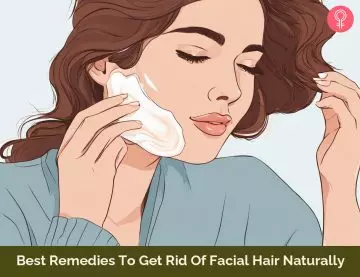
Image: Stable Diffusion/StyleCraze Design Team
Personal Experience: Source
StyleCraze's articles are interwoven with authentic personal narratives that provide depth and resonance to our content. Below are the sources of the personal accounts referenced in this article.
i. Removing my facial hair part 1 – what are the options?https://totallyaddictedtobase.wordpress.com/2016/10/16/removing-my-facial-hair-part-1-what-are-the-options/
References
Articles on StyleCraze are backed by verified information from peer-reviewed and academic research papers, reputed organizations, research institutions, and medical associations to ensure accuracy and relevance. Read our editorial policy to learn more.
- Honey in dermatology and skin care: a review
https://pubmed.ncbi.nlm.nih.gov/24305429/ - Potential health benefits of avenanthramides of oats
https://pubmed.ncbi.nlm.nih.gov/19941618/ - Turmeric
https://www.ncbi.nlm.nih.gov/pmc/articles/PMC9457827/ - Turmeric, the Golden Spice From Traditional Medicine to Modern Medicine
https://www.ncbi.nlm.nih.gov/books/NBK92752/ - Beauty and Health Benefits of Solanum tuberosum Juice for Skin and Hairs: A Review
https://ijppr.humanjournals.com/wp-content/uploads/2020/08/4.Mukesh-Mohite-Smita-Shete-Akshay-Lingayat.pdf - Histological evaluation of hair follicle due to papain’s depilatory effect
https://pubmed.ncbi.nlm.nih.gov/17314016/ - Possible efficacy of Lavender and Tea tree oils in the treatment of young women affected by mild idiopathic hirsutism
https://pubmed.ncbi.nlm.nih.gov/23211454/ - Plant-Derived Antioxidants: Significance in Skin Health and the Ageing Process
https://www.ncbi.nlm.nih.gov/pmc/articles/PMC8776015/ - Honey–a remedy rediscovered and its therapeutic utility
https://pubmed.ncbi.nlm.nih.gov/18650599/ - Sugaring: an ancient method of hair removal
https://pubmed.ncbi.nlm.nih.gov/11277903/ - A method to improve the efficacy of topical eflornithine hydrochloride cream
https://www.ncbi.nlm.nih.gov/pmc/articles/PMC4348346/ - The Effects of Magnesium and Vitamin E Co-Supplementation on Hormonal Status and Biomarkers of Inflammation and Oxidative Stress in Women with Polycystic Ovary Syndrome
https://pubmed.ncbi.nlm.nih.gov/30565017/ - Magnesium-Zinc-Calcium-Vitamin D Co-supplementation Improves Hormonal Profiles
Biomarkers of Inflammation and Oxidative Stress in Women with Polycystic Ovary Syndrome: a Randomized - Association of Diet with Hirsutism in Females of Reproductive Age
https://applications.emro.who.int/imemrf/Pak_J_Med_Res/Pak_J_Med_Res_2012_51_4_139_142.pdf





